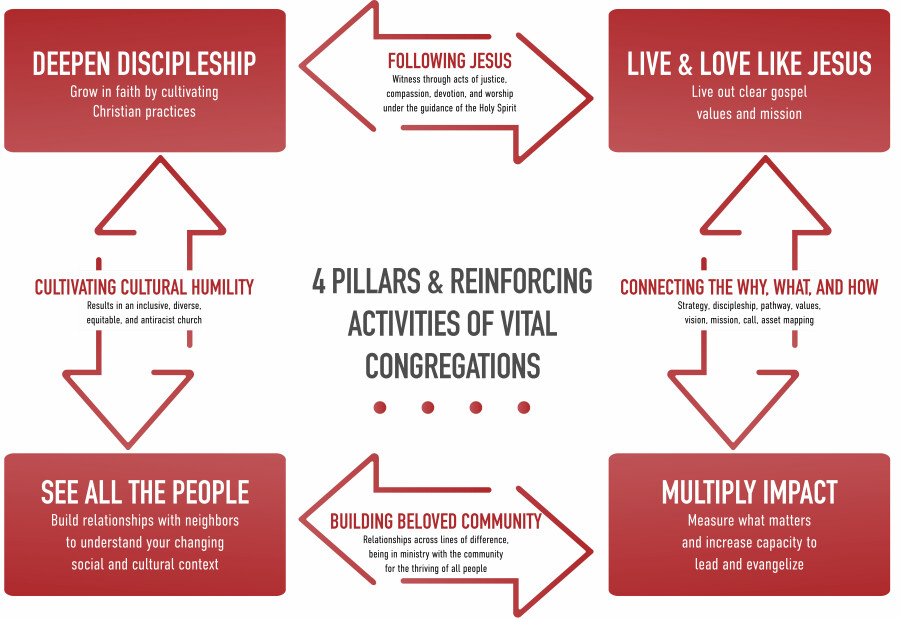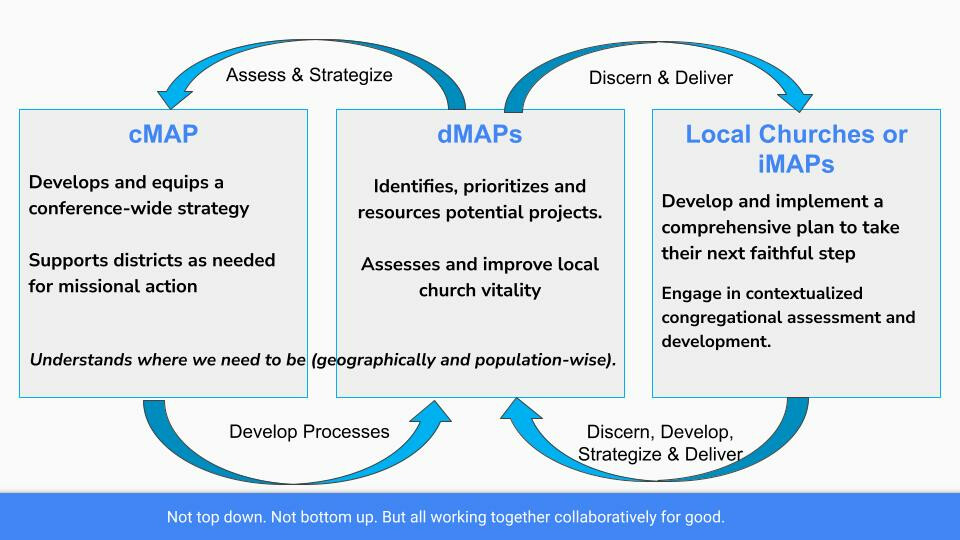Missional Action Planning (MAP)
Leveraging & Strengthening Our Presence for the Good of All
Missional Action Planning (MAP) is a mindset and a process to enable 100 percent of our congregations to become 100 percent vital and thriving. It is a collaborative process of discernment, prioritization and stewardship as we, together, seek to love God and neighbor and live out the Great Commission.
Missional Action Planning awakens our spiritual imagination as we reconsider what it means to take up whole-life evangelism and embody justice as a spiritual discipline. This flows out of our profound commitment to God and is evident in our life of divine worship and spiritual disciplines.
While Jesus is our strong and certain foundation, spiritual leaders are being called upon to lift up four pillars that enable congregations to thrive. Like Jacob’s ladder, they create a framework for decision-making, ministry and mission. Congregations must 1.) see and respect all people; 2.) deepen discipleship; 3.) live and love like Jesus; and 4.) multiply and grow their impact. These four pillars are self-reinforcing and non-linear. If any one of them is absent, the church can’t really be vital. The activities between these pillars provide ongoing support and energy for churches to begin to meaningfully create, discover, connect, and imagine. (learn more about church vitality here at bwcumc.org/vitality.

As new streams of Methodism emerge and disaffiliation begins to happen, we know that there will be people, sometimes many in a congregation, that might leave the denomination. They may, or may not, take their building(s) with them. In addition, we have some congregations who believe that trying to maintain large, demanding buildings limits their ability to be nimble or flexible in the way they’d like to do ministry.
How might we reimagine these sacred spaces in this present age? How might we meet current and emerging community dreams in practical and transformational (not transactional) ways? How must we shift so that we aren’t so inwardly focused that we miss God’s calling beyond the walls of our buildings.
This missional ministry works hand-in-hand with impacted communities. In other words, this transformational ministry as empowered by God involves a partnership between God, people, and creation. Therefore, our role is not to tell the communities in which we serve what they or the land needs. Nor is our role to be a form of Savior. We are to be present as learners, sojourners and faithful disciples of Jesus Christ who discern with residents God’s collective desire for our lives, God’s earth, and spaces God entrusts to us for such a time as this.
How this repurposing or re-imagining of assets is done will differ dramatically from community to community. Some contexts might call for the creation of a new faith expression, others might call for community resource centers, or affordable housing, or any number of creative, life-giving options. Therefore, it is essential that we remain adaptive, prayerful, honest and flexible.
As the MAPing process begins, two Scripture passages undergird this work: Isaiah 61:1-4 and Acts 2: 37-47.
Isaiah 61:1-4 (NRSV)
The spirit of the Lord God is upon me,
because the Lord has anointed me;
he has sent me to bring good news to the oppressed,
to bind up the brokenhearted,
to proclaim liberty to the captives,
and release to the prisoners;
to proclaim the year of the Lord’s favor,
and the day of vengeance of our God;
to comfort all who mourn;
to provide for those who mourn in Zion—
to give them a garland instead of ashes,
the oil of gladness instead of mourning,
the mantle of praise instead of a faint spirit.
They will be called oaks of righteousness,
the planting of the Lord, to display his glory.
They shall build up the ancient ruins,
they shall raise up the former devastations;
they shall repair the ruined cities,
the devastations of many generations.
Imagine what building up the ancient ruins and what repairing the ruined city would look and feel like in your context. As we meditate on these words, let us consider them through the lenses of faithfulness and innovation. How has your church’s relevance and community presence increased or declined over the past five years? What will happen to our congregational vitality and community impact if we maintain a “death-grip” on our buildings and not adapt to meet current spiritual and communal needs while being faithful to the Gospel? How must we reimagine what is possible in and beyond local churches? What can we do now, tomorrow and within the next year that will enable more people to experience the practical love of God? What sparks or ignites our innovative thinking? What must we release? What must we repair? Where must we rebuild? What do we risk by not acting? What is our next faithful step?
Acts 2: 37-47
Now when they heard this, they were cut to the heart and said to Peter and to the other apostles, “Brothers, what should we do?” Peter said to them, “Repent, and be baptized every one of you in the name of Jesus Christ so that your sins may be forgiven; and you will receive the gift of the Holy Spirit. For the promise is for you, for your children, and for all who are far away, everyone whom the Lord our God calls to him.” And he testified with many other arguments and exhorted them, saying, “Save yourselves from this corrupt generation.” So those who welcomed his message were baptized, and that day about three thousand persons were added. They devoted themselves to the apostles’ teaching and fellowship, to the breaking of bread and the prayers.
Awe came upon everyone, because many wonders and signs were being done by the apostles. All who believed were together and had all things in common; they would sell their possessions and goods and distribute the proceeds[b] to all, as any had need. Day by day, as they spent much time together in the temple, they broke bread at home[c] and ate their food with glad and generous[d] hearts, praising God and having the goodwill of all the people. And day by day the Lord added to their number those who were being saved.
As we read this passage, what challenges you? What passages or statements do you resonate with at this moment? If we truly believe that all things belong to the Lord, how will we begin to reframe our narrative and reorient our approach to our buildings and everything else God entrusts into our care?
Why Missional Action Planning?
- To live out an expression of Acts 2 and Isaiah 61
- To care for the missional impact of multiple streams of Methodism including disaffiliation
- To assist 100% of our churches in becoming 100% vital and thriving
What is a Missional Mindset?
- Discipleship-Minded Not Membership-Driven
- Make disciples of Jesus Christ for the transformation of the world
- Reconciliation – First to God, Then with One Another
- Blessed to be a blessing
- Ministry with and not Ministry to
- Sharing Leadership with Community
- Entrusting the Community (Not Almsgiving)
- Embracing the Skills and Abilities of Those in the Community
- Authentic and Relevant not Status Quo: If there is a church tradition that is getting in the way of our mission to be with and for our community, we will not be afraid to choose our community (as Jesus did)
Who Forms the Missional Action Planning Teams and What do They Do?

There are three aspects of Missional Action Planning (MAPing): Conference, District and Local. This is a collaborative process — we are all in this together! The discernment of where God is calling us and the stewardship and prioritization of resources is interactive and informed by local teams and data – it is not top-down.
Conference MAP Team (cMAP)
Purpose: To develop and equip a conference-wide strategy for leveraging and strengthening our United Methodist presence for the thriving of communities
Membership:
- Pastors with Missional Action Experience
- Trustee’s Chair
- Council on Finance and Administration Chair
- Treasurer
- Dean of the Cabinet
- [Director of Innovative Evangelism]
- [Executive Minister of Beloved Community]
- Director of Connectional Ministries
- Chief Program Officer and Project Coordinator
District/Regional MAP Team (dMap)
Purpose: To identify, prioritize and resource potential projects
Membership includes but is not limited to:
- District Superintendent
- New Faith Expressions Board Member or someone with a track record of impact
- District Board of Building and Locations Member
- Property Analyst
- MissionInsite Analyst (to be identified by October 30)
- Community Organizer
Local MAP Team (iMap)
Purpose: To shape and lead a Missional Action Project into fruition
Membership:
- Local Church Leaders
- Local Community Partners
- Others as project dictates
